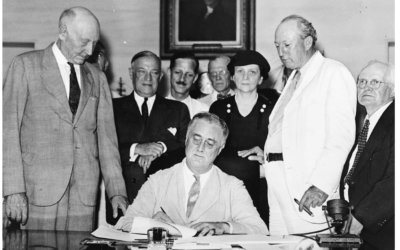Public service workers, including those in health, child services, social benefits, and more, are at an exceptionally high risk for burnout, but recent research indicates that the most powerful causes and remedies for this burnout might not be what many would expect. While it may appear that public service burnout is primarily caused by the emotionally demanding nature of the work – helping individuals and families through some of their most difficult moments – research paints a notably different picture. Today, public service burnout is just as much if not more about agency processes and systems as it is about the difficult nature of client interactions, which highlights the potential for process improvements as a remedy to public service burnout.
Scope and Impact of the Public Service Work Burnout Crisis
In 2022, a Public Health Workforce Interests and Needs study revealed that almost one in three public health employees were considering leaving their organization in the next year, and nearly half reported the intention to leave in the next five years. Burnout was one of the most often cited reasons for considering leaving, second only to pay. Within child welfare specifically, even more concerning numbers are reported, with almost half of respondents indicating some intention to leave their current agency as soon as possible, and less than a third reporting an intention to be with that agency or with child welfare in five years, positioning child welfare as one of the highest turnover professions. This study similarly cited burnout as a powerful predictor of intent to leave an agency or profession.
Burnout, especially when seen in staggering numbers like those above, affects not only the employee and their quality of life – it also tends to have significant direct and indirect impacts on clients, other employees, and the long-term success and progress of the agency.
In the case of child welfare specifically, a social worker’s disengaged attitude could mean that they miss opportunities to motivate families to improve behaviors or miss important details in their assessments. This decreases the accuracy and helpfulness of case reports, leading to case plans and placements that are less well-informed and not as tailored to the family, which can have serious, long-term impacts for a child’s placement, safety, and well-being. A one-size fits all approach may keep plans open 6-9 months longer than a tailored approach, and not fully informed placement decisions may require future changes in both housing and schools. Research tells us that each time a child changes schools, that change may result in 4–6 months of delay in academic progress.
In addition to disengaged employees, burnout is also highly correlated with the high turnover rates previously discussed, which in turn cost agencies money, time, and training efforts, pulling these resources away from other important initiatives. The loss of a caseworker, for example, can cost an agency 30%–200% of the lost caseworker’s yearly salary in addition to that caseworker’s expertise.
Causes of Burnout: It’s Not Just About the Emotional Demands
Research from the National Child Welfare Workforce Institute lists six predominant pathways to burnout:
- A focus on timeliness rather than quality of work
- Secondary trauma (also referred to as vicarious trauma or compassion fatigue)
- The perception that employee opinions don’t matter
- The task of resolving (“cleaning up”) difficult work left by others
- Personal problems
- Inability to see the impact of one’s work
Recent research further categorizes caseworker burnout into three groups: personal burnout (related to factors outside work), client-related burnout (stemming from client interactions), and work-related burnout (from aspects of work other than clients, such as work processes and systems). For child welfare workers, work-related burnout was the highest predictor of job turnover, impacting nearly half of decisions to leave the child welfare profession and over half of decisions to leave a current agency. Client-related burnout was a slightly less powerful predictor, impacting about 40% of decisions to leave the profession and less than a third of decisions to leave an agency. So, while the emotionally demanding nature of client interactions does cause burnout and turnover, the systems and processes of public service work are actually stronger predictors of both.
How Hope and Process Improvements Work Together to Reduce Burnout
Both resilience and hope have been identified as important qualities that help reduce the experience and impact of burnout, and, within child welfare agencies specifically, hope has been shown to be more than twice as strong a predictor of reduced burnout as resilience. The study this is from defines hope in practical terms: as having confidence in an engaged process and your/its ability to succeed. This highlights the importance of developing processes that workers truly believe are effective.
Because work-related burnout is the type most predictive of employee turnover – and because hope in process efficacy seems to be the most powerful mediator of burnout – optimizing processes and systems is likely to be our strongest and most effective move in reducing and alleviating burnout, and one that deserves more focus. Drawing on the pathways to burnout listed above, some useful process-related goals might be to:
- Help alleviate the employee experience of racing against the clock
- Gather and meaningfully incorporate employee opinions
- Reduce the amount and difficulty of case handoffs
- Increase the visibility of work and its positive outcomes
At Change & Innovation Agency (C!A), we’ve seen firsthand how thoughtful process and system redesign can achieve these goals and more. Our core focus is enhancing capacity, which empowers workers to accomplish more in less time and tends to remove a lot of the time pressure from public service work. For example, thoughtful system integrations and enhanced communication features can decrease instances of rework, and automation can reduce the amount of time workers spend on basic tasks, allowing workers to slow down and focus on providing quality service for more complex tasks. Capacity gains also free up more time for managers to listen to employees and ensure that employee feedback is incorporated in future process improvements.
Enhanced visibility through work routing and tracking systems is also key. These systems can facilitate easier case handoffs with more detailed work logs, but they also help managers and employees to assess, recognize, and celebrate individual and team progress, such as improved timeliness or accuracy rates, or, more specific to child welfare: improved long-term placement rates.
As agencies increase hope and decrease burnout through process improvements, they are likely to experience renewed employee engagement, lower turnover rates, and overall better outcomes for the agency and its clients – outcomes worth celebrating. While embarking on such process improvements may seem overwhelming in the face of high burnout and turnover, requiring more time than agencies currently have, C!A has been there and is ready to help agencies overcome the burnout/turnover cycle for good.
Learn more about how C!A has helped agencies across the country enhance capacity and reduce burnout through process and system improvements here or reach out to chat more about how we can help.
Additional Resources:
Resources for Burnout in Tribal Child Welfare
Stress First Aid: Manuals and Resources for Health Care Workers – PTSD: National Center for PTSD







